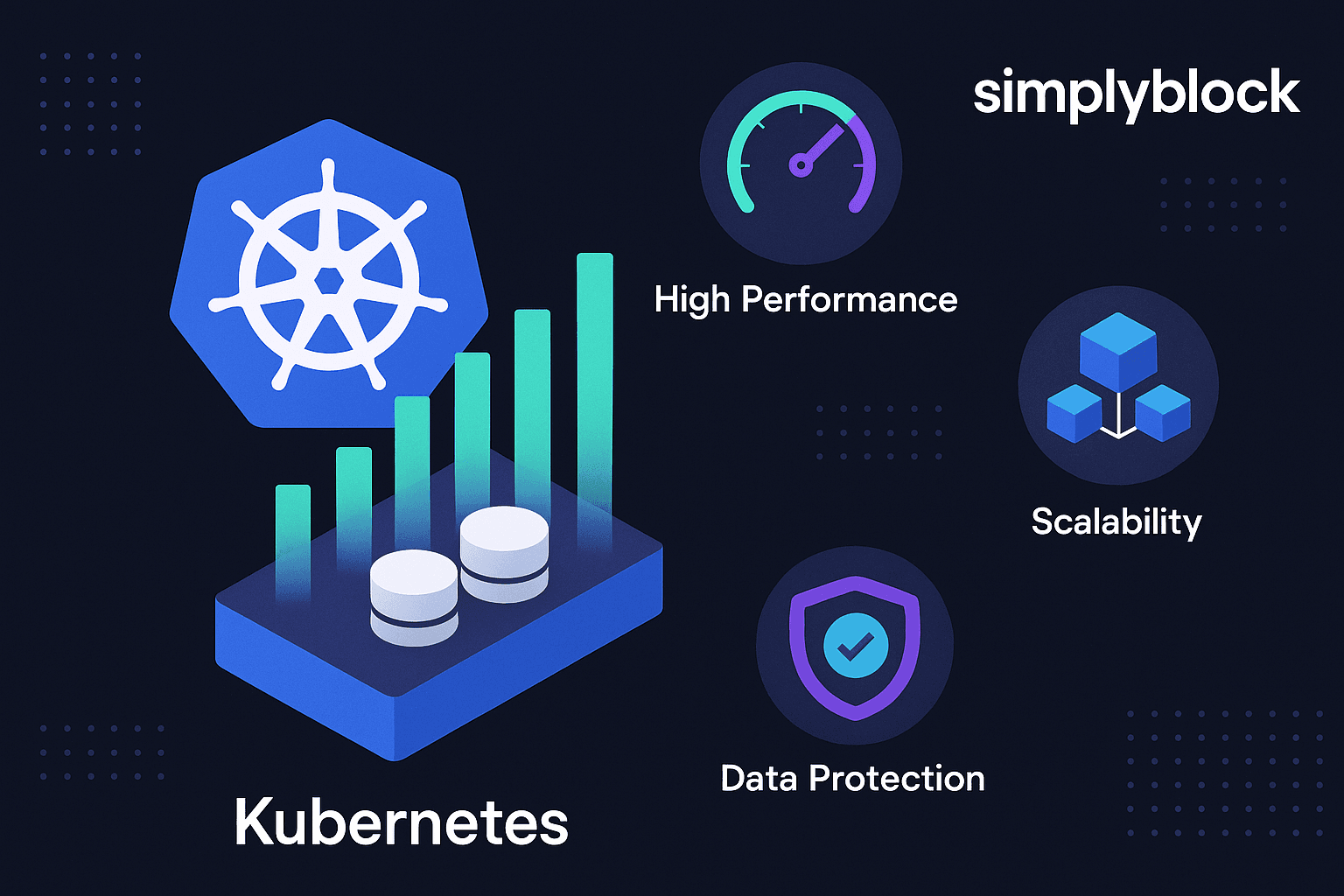Kubernetes is the standard for orchestrating containerized applications, but storage remains one of the most challenging aspects of managing stateful workloads. While stateless apps scale easily, databases, caches, and other persistent services in Kubernetes require durable storage solutions.
Simplyblock addresses these challenges with NVMe-over-TCP storage and zone-independent volumes, making persistent workloads in Kubernetes faster, more resilient, and easier to manage across clusters.
Breaking Down Kubernetes Storage Complexity
Kubernetes provides Persistent Volumes (PVs) and Persistent Volume Claims (PVCs) to abstract storage. However, performance issues, scaling limitations, and zone restrictions often appear as clusters grow.
This can lead to slower databases, unpredictable failovers, and higher operational overhead.By integrating simplyblock, storage becomes both high-performance and zone-independent. This ensures that Kubernetes pods accessing stateful volumes remain responsive, even during rescheduling events.
🚀 Use simplyblock with Kubernetes for Persistent Volumes
Simplyblock simplifies storage for stateful workloads while ensuring performance across clusters.
👉 Use simplyblock for VMware Storage →
Step 1: Provisioning Persistent Volumes with Simplyblock
To provide persistent volumes, first create and attach simplyblock volumes:
sbctl pool create k8s-pool /dev/nvme0n1
sbctl volume add k8s-data 100G k8s-pool
sbctl volume connect k8s-data
Format and mount the volume:
mkfs.ext4 /dev/nvme0n1
mkdir -p /mnt/k8s
mount /dev/nvme0n1 /mnt/k8s
Update /etc/fstab to persist the mount:
/dev/nvme0n1 /mnt/k8s ext4 defaults 0 0
This provides a backing volume for Kubernetes Persistent Volumes.

Step 2: Defining PVCs in Kubernetes for Simplyblock
Next, configure Kubernetes to use the mounted simplyblock directory. A sample Persistent Volume (PV) and Persistent Volume Claim (PVC) manifest:
apiVersion: v1
kind: PersistentVolume
metadata:
name: sb-pv
spec:
capacity:
storage: 100Gi
accessModes:
– ReadWriteOnce
hostPath:
path: “/mnt/k8s”
—
apiVersion: v1
kind: PersistentVolumeClaim
metadata:
name: sb-pvc
spec:
accessModes:
– ReadWriteOnce
resources:
requests:
storage: 100Gi
For further details, Kubernetes provides an official Persistent Volumes guide.
Step 3: Scaling Persistent Storage for Stateful Pods
As applications store more data, Kubernetes PVCs may require additional capacity. Simplyblock supports dynamic resizing:
sbctl volume resize k8s-data 200G
resize2fs /dev/nvme0n1
This enables scaling without downtime. When paired with NVMe-over-TCP storage, Kubernetes clusters can maintain consistent performance while expanding volumes.
Step 4: Zone Independence in Stateful Kubernetes Deployments
By default, Kubernetes workloads may be restricted to a single availability zone for storage. This creates limitations during rescheduling or failover. With simplyblock’s zone-independent volumes, stateful pods can maintain access to their data regardless of node or zone.
This approach aligns well with hybrid multi-cloud storage strategies where Kubernetes clusters span multiple environments.
Step 5: Replicating Storage for Kubernetes Applications
Simplyblock enables replication of volumes to support failover and data durability:
sbctl volume replicate k8s-data –zones=zone-a,zone-b
This reduces recovery times and prevents data loss. Administrators deploying mission-critical workloads can reference the Kubernetes StatefulSets guide for complementary replication strategies at the application level.
Improving Kubernetes Storage Efficiency
Kubernetes adoption at enterprise scale requires not just flexible scheduling, but reliable persistent storage. Simplyblock reduces complexity with CLI-based volume management, allowing storage provisioning to keep pace with application growth.
Features such as edge and air-gapped storage expand deployment options, while technical details are documented in the simplyblock Documentation.
Questions and Answers
Simplyblock provides NVMe over TCP–based volumes that drastically cut latency and boost throughput. This ensures Kubernetes workloads, including stateful applications, achieve higher performance without being limited by traditional storage.
Yes, simplyblock helps reduce cloud spend by consolidating volumes and applying Kubernetes cost optimization strategies. This allows you to scale Kubernetes storage without overspending on underutilized disks.
Absolutely. simplyblock enables seamless integration for databases on Kubernetes, ensuring mission-critical apps like Postgres, MongoDB, or KeyDB get low-latency, durable storage.
Simplyblock provides instant snapshots and replication that simplify Kubernetes backup workflows. These features ensure quick recovery with minimal downtime, making disaster recovery more efficient for containerized workloads.
Unlike generic cloud disks, simplyblock offers predictable NVMe-grade performance, enterprise features like encryption, and easier scaling. This makes it a better choice for performance-sensitive Kubernetes workloads where storage speed and reliability are critical.

